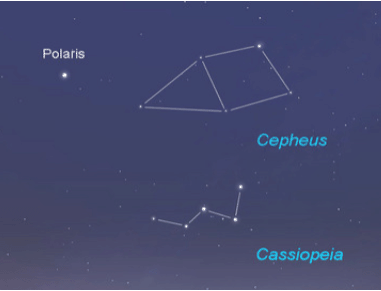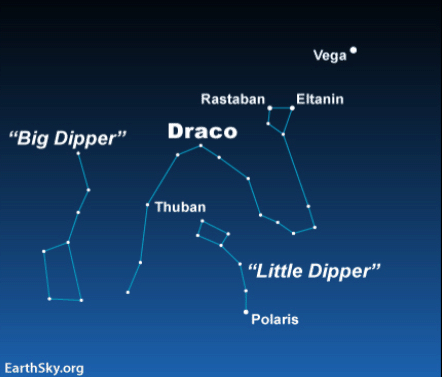Year Round Constellations
The Bigger Dipper, The Little Dipper and The North Star

The Big Dipper is made up of 7 bright stars —three in the handle, four in the cup and is easily visible, even in areas with pronounced light pollution. The two pointer stars on the end up the cup form a diagonal line across the sky to Polaris, the North Star, which always points north. Polaris is also the last star on the end of Little Dipper, a constellation which can only be seen in dark skies.
The Big Dipper and Little Dipper are only small parts of much larger constellations, known as Ursa Major and Ursa Minor, or, the big and little bear. In Greek mythology, Callisto was turned into a bear (Ursa Major) to protect her from the wrath of the goddess Hera. Her son, not recognizing her as a bear, tried to shoot Callisto. To protect her, Zeus intervened and placed mother and son in the skies in bear form, where they could be together forever.
Cassiopeia and Cepheus

Cassiopeia, the queen, and Cepheus, the king, are located close to Polaris. Cassiopeia is especially easy to spot since it forms a “w” shape, out of five bright stars. Cepheus is located just above Cassiopeia, where five stars make a pentagon shape.
In Cepheus, the famous variable star, Delta Cephei, can be see every 5.36 days. Delta Cephei is a double star, which can be seen on its brightest cycle with a low magnification (46x).
In mythology, Cassiopeia and Cepheus were the parents of Princess Andromeda. Cassiopeia was very vain, which provoked the wrath of the gods, who sent a sea monster, Cetus, to their kingdom. Cepheus and Cassiopeia were told that they only way they could appease the monster Cetus was to sacrifice their daughter to him. Andromeda was rescued by the hero Perseus and his flying horse Pegasus, and was then returned home to her parents, where turmoil was breaking out in their court. Perseus used the severed head of the Gorgon, Medusa, to turn the corrupt nobles to stone, but unfortunately, Cepheus and Cassiopeia were also turned to stone. Perseus and Andromeda pleaded with the gods to spare Andromeda’s parents, so the gods placed them in the stars. To further punish her for her vanity, Cassiopeia appears upside down in the sky, during the winter months.
Draco

Draco is best seen in July, around 9 pm, but can be seen during the whole year. Although Draco is generally called “the dragon,” it directly translates from Latin to mean “the long serpent.”
On the tail of Draco is a star called Thuban, which pointed north during the time of the Ancient Egyptians. Draco also contains the Cat’s Eye Nebula, the faint Draco Dwarf Galaxy, and several double stars.
Draco has several myths associated with it. According to Greek mythology, Draco was the dragon that guarded the golden apples at the garden Hesperides, which Hercules was charged to retrieve as part of his 12 labors. Hercules killed Draco in this task, which explains why Hercules appears close to Draco in the sky. Draco was placed in the sky to reward his faithful guarding of the garden. Early Christians thought Draco represented serpent that tempted Adam and Eve in the Garden of Eden with the apple.
To read more about these constellations and get the latest update on astronomical news, visit EarthSky.
Download a PDF Version of this information
